
Eilat is one of the most important spots for migratory birds in the world. The only overland bridge between Europe, Asia and Africa is also a bottle-neck that serves hundreds of millions of migratory birds. Moreover, these birds in Eilat, are preparing themselves for the most challenging task of crossing the foodless and hostile Saharan desert. Eilat area that used to be a large and rich saltmarsh that consisted the last "fueling station" before the desert for these birds, suffered human development that left nothing of this important habitat.
The main work of the International Birding and Research Center in Eilat (IBRCE) is to maintain and improve the habitats of the birds' sanctuary and to renew the food source of the migratory birds in Eilat. In addition, we are deeply involved in nature conservation acts in the area that protect the birds or prevent hazards, taking part in governmental discussions regarding planned infrastructure that have impact on birds such as wind turbines, developing sensitive areas etc… We also promote improving not natural habitats in the area in collaboration with Eilat's and Eilot's municipal councils, farmers, foresters and even the army.
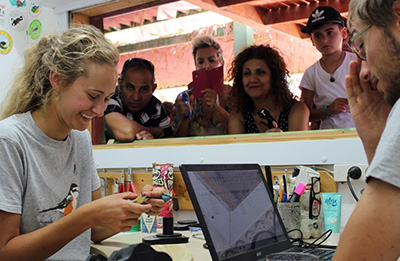 The IBRCE conduct research that constantly monitors the physical condition of the migratory birds in our ringing station for the last 25 years and reassess our conservation policy and work to safeguard the bird's flyway accordingly. We survey hotspots in the area that serves the migratory birds and survey the massive passage of soaring birds in spring. We are also involved in research that learns about the impact of global climate changes on bird's migration and see ourselves as an open platform for researchers to conduct their own research as long as it serves nature and birds conservation.
The IBRCE conduct research that constantly monitors the physical condition of the migratory birds in our ringing station for the last 25 years and reassess our conservation policy and work to safeguard the bird's flyway accordingly. We survey hotspots in the area that serves the migratory birds and survey the massive passage of soaring birds in spring. We are also involved in research that learns about the impact of global climate changes on bird's migration and see ourselves as an open platform for researchers to conduct their own research as long as it serves nature and birds conservation.
The outreach activity of the IBRCE includes transforming the knowledge, love and urge to help birds and nature to local groups and families in the bird's sanctuary, conduct 3 large communal events every year to raise the environmental awareness and host the pupils of Eilat in the bird's sanctuary, where they learn how special their town is and how much responsibility we have on our shoulders to help the birds preform their migration successfully. We also teach in 3 different schools an educational program we created, called "the migration madness in Eilat".
The IBRCE also takes important role in regional cooperation projects with our Jordanian and Palestinian partners to enhance the capabilities and share experience towards cross border nature conservation and environmental awareness.
Our partners in Israel are the SPNI, KKL, INPA, Municipality of Eilat and the ministry of tourism.
Our Team
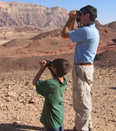 Noam Weiss - Director. Is a birder since he was 10. Did his main research projects about extreme desert birds population trends and habitat selection. His main research species were the Desert Tawny Owl , hooded, White – crowned and mourning Wheatears and Blackstarts.
Noam Weiss - Director. Is a birder since he was 10. Did his main research projects about extreme desert birds population trends and habitat selection. His main research species were the Desert Tawny Owl , hooded, White – crowned and mourning Wheatears and Blackstarts.
 Tzadok Tzemach - manager of the bird's sanctuary site. Tzadok is into birding for 15 years and his main love is for ringing birds of prey and he has a soft corner in his heart for Pharaoh Eagle Owls that he has a history of saving from barb fences and injuries.
Tzadok Tzemach - manager of the bird's sanctuary site. Tzadok is into birding for 15 years and his main love is for ringing birds of prey and he has a soft corner in his heart for Pharaoh Eagle Owls that he has a history of saving from barb fences and injuries.
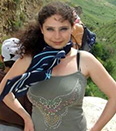 Leaby Yeframov - Secretary and office and shop manager. Leaby will help you find your way in the bird's sanctuary, help you book a guided tour or sell you something in the shop.
Leaby Yeframov - Secretary and office and shop manager. Leaby will help you find your way in the bird's sanctuary, help you book a guided tour or sell you something in the shop.
Mail: ibrce.office@gmail.com, Phone: 050-7671290.
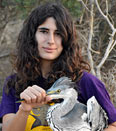 Lior Bornshtein -
Lior is the year long volunteer at the IBRCE. After three years of volunteering in Agamon Hula Lake she decided to make a change and replace the green Hula valley with the Desert Mountains of Eilat. Learn more about birds and help to protect them is her main target and she is planning to continue to do so in the future. Lior helps with the ringing process, gives guided tours and takes care of the park maintenance.
Lior Bornshtein -
Lior is the year long volunteer at the IBRCE. After three years of volunteering in Agamon Hula Lake she decided to make a change and replace the green Hula valley with the Desert Mountains of Eilat. Learn more about birds and help to protect them is her main target and she is planning to continue to do so in the future. Lior helps with the ringing process, gives guided tours and takes care of the park maintenance.
History
Eilat and the southern Arava region are important stations on the migratory routes of birds from Europe and Asia as they make their way to Africa and when returning back to their breeding grounds. This is essentially the only land bridge to Africa on this migratory route and acts as a bottleneck which funnels millions of birds through a small area. Hundreds of thousands of birds stop to rest and feed here before and after crossing the Sahara desert.
In 1949 the city of Eilat was founded and by the 1950's the southern Arava region had been identified as an especially important point for birds and birders. Uriel Sapriel, the first ranger of the SPNI at Eilat (the Society for Protection of Nature in Israel), studied the area on a very special work vehicle, a camel! As a result of his studies an article was published in the "Nature & Land" magazine entitled "Observations of bird migration in the Eilat region". In the article Uriel shed light on the importance of the region to world birding.
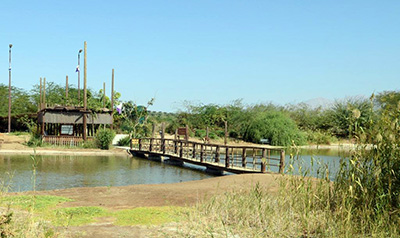 The energetic development of Eilat in the 1950's and 1960's saw the city expand on to the salt-flat areas. This previously untouched area had provided plentiful food and water for birds and other animals. Now it had become a site for municipal infrastructure, agriculture, an airport and the city dump.
The energetic development of Eilat in the 1950's and 1960's saw the city expand on to the salt-flat areas. This previously untouched area had provided plentiful food and water for birds and other animals. Now it had become a site for municipal infrastructure, agriculture, an airport and the city dump.
In 1967, a group of American ringers led by Steve Peterson, carried out the first ringing operation in the Eilat region. In the same year a young Nahal soldier, Barry Pinshaw, joined Peterson's group and they were soon joined by Bruria Gal, a member of kibbutz Lahav. This group continued ringing and studying birds in the Eilat region until 1971. At this point Bruria took control of the studies and with additional ringers continued the bird studies throughout the 1970's and early 1980's.
In the 1970's, a group of Danish birders led by Stine Christenson, carried out the first raptor migration study in the Eilat and Sinai region. They found that no fewer than 300 000 raptors pass through the area each year. At the time this was an astonishing figure and Eilat became the number one spot in the old world for raptor watching during the spring migration. This brought to the area birders from all over the world throughout the 1970's and 1980's.
Hadoram Shirihi, a Jerusalem birder and ringer, arrived in Eilat in 1984. He made Eilat his home and through his many ringing projects and in-depth studies he discovered new species inIsrael and wrote the most comprehensive bird guide at the time, "The Birds of Israel" in 1996.
In the 1980's, With the leadership of Mr. Shmulik Tagar, the Jewish National Fund, the Parks and Nature Authority, the City of Eilat and the Tourism Ministry joined forces on a project designed to rehabilitate the city dump and return the salt-flats to a semi-natural state. They founded the "International Birding & Research Centre Eilat" and started work on an alternative area for the birds. In 1993 the bird sanctuary was officially opened on land reclaimed from the city dump which had operated until the 1970's. This was a unique opportunity to turn contaminated land into an environmentally friendly area for both birds and people. Today the park is not a natural salt-flat but an area managed to imitate it's former state with salt ponds, replanted natural flora and the evaporation ponds of the salt company which attracts many waders and flamingo.
From this time till now the area has seen many developments and upheavals in the fields of bird-watching and tourism. All these have not prevented the development of bird studies, ringing, educational projects and guiding at the IRBCE. Each year thousands of visitors tour the park, Eilat and southern Arava region in search of fascinating birds and quality leisure time.
In the last few years, foreign tourism has risen sharply again with thousands of bird-watchers and photographers visiting Eilat each year. At the same time bird-watching in Israel has become increasingly popular bringing more local birders to Eilat each year. Many attend the Spring Bird Migration Festival organized by the IOC and others attend the Families Festival, a joint venture of the IBRCE and the Arava communities.
We are looking to the future and planning to develop the area in an intelligent manner that will allow both our feathered friends and two-legged visitors to gain maximum advantage from the park. We hope to expand our educational projects for the local population and tourists alike. At the same time we hope to continue the study of birds and expand our knowledge of them in the research area. These goals will enable us to preserve this important area for the birds in co-operation with other environmental bodies who share our goals.